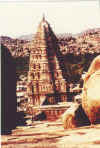|
|
||||
|
Archaeology
Banking & Management
Adventure & Outdoors
Films
Heritage
People
Books Craft Shop
|
|
|
||
|
the-south-asian.com November 2000 |
||||
|
Page 1 of 2
Hampi – World heritage site in danger Saikat Neogi L-R: Decorated step-tank at the royal enclosure area in Hampi; Lotus Temple;Main Tower of Virupaksha temple
‘Hampi, austere and grandiose, is the site of the last capital of the last great Hindu kingdom of Vijayanagar, whose extremely rich princes built Dravidian temples and palaces which won the admiration of travellers between the 14th and 16th centuries. Conquered by the Moslems in 1565, the city was pillaged over a period of six months, and then abandoned. ‘- UNESCO
To the outside world it was a gateway to the magnificent kingdom of southern rulers. To its people it was the greatest empire ever in India---a monument in stone. To the devout it was a place of pilgrimage surrounded by magnificent temples.Over 800 years ago Hampi, the seat of the great Vijayanagar Empire in south India, reflected political maturity, religious tolerance and the grandeur of Indian art and architecture. For centuries this one time symbol of Indian history and culture was buried in the mists of time. In fact till a few years ago only a few people knew about Hampi. It was just an insignificant town near Hospet in Bellary district of Karnataka, 350 kilometres from Bangalore.Back in the eighties when a farmer discovered a few artefacts while ploughing his fields, the Archaeological Survey of India began shining its torch on the remains of what turned out to be a royal city.A decade after the efforts Hampi has been declared a World Heritage Site by UNESCO and has suddenly started attracting Indian and foreign tourists, historians and archaeologists -- all flocking to see the magnificence and grandeur of the erstwhile Vijayanagar empire which ruled south India from 1336 to 1565 AD.According to Indian historians, the archaeological findings in the 25 square kilometre area have thrown light on the rich cultural linkages of the powerful kingdom of south India. Some of the porcelain artefacts excavated from the site clearly indicate that Chinese pottery was used in almost every household and imported from China in bulk quantities. Says Dr. K.P. Poonacha, director (monuments), Archaeological Survey of India," The excavation work at Hampi started in 1976 under a national excavation project but had to be stopped midway and was resumed only in the nineties. That's when historians discovered the amazing foresight of the Vijayanagar rulers."The scientific temperament of the Chalukya and Hoysala kings who ruled Hampi is evident from their meticulous town planning. Great attention was paid to the civic and sanitary system. There was an efficient and effective water management system with public and private baths. Excavations have also brought to light the existence of a network of wide, tree-lined roads. The officers' quarters had stables attached to them and areas were clearly marked out for congregation of people as also markets and public parks---all pointing to an advance state of civilisation.
|
||||
| Copyright © 2000 [the-south-asian.com]. Intellectual Property. All rights reserved. | ||||
| Home |


